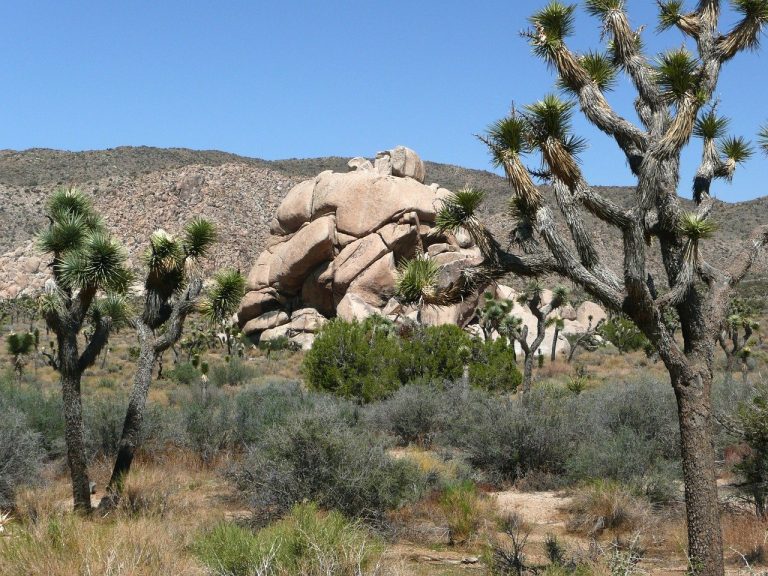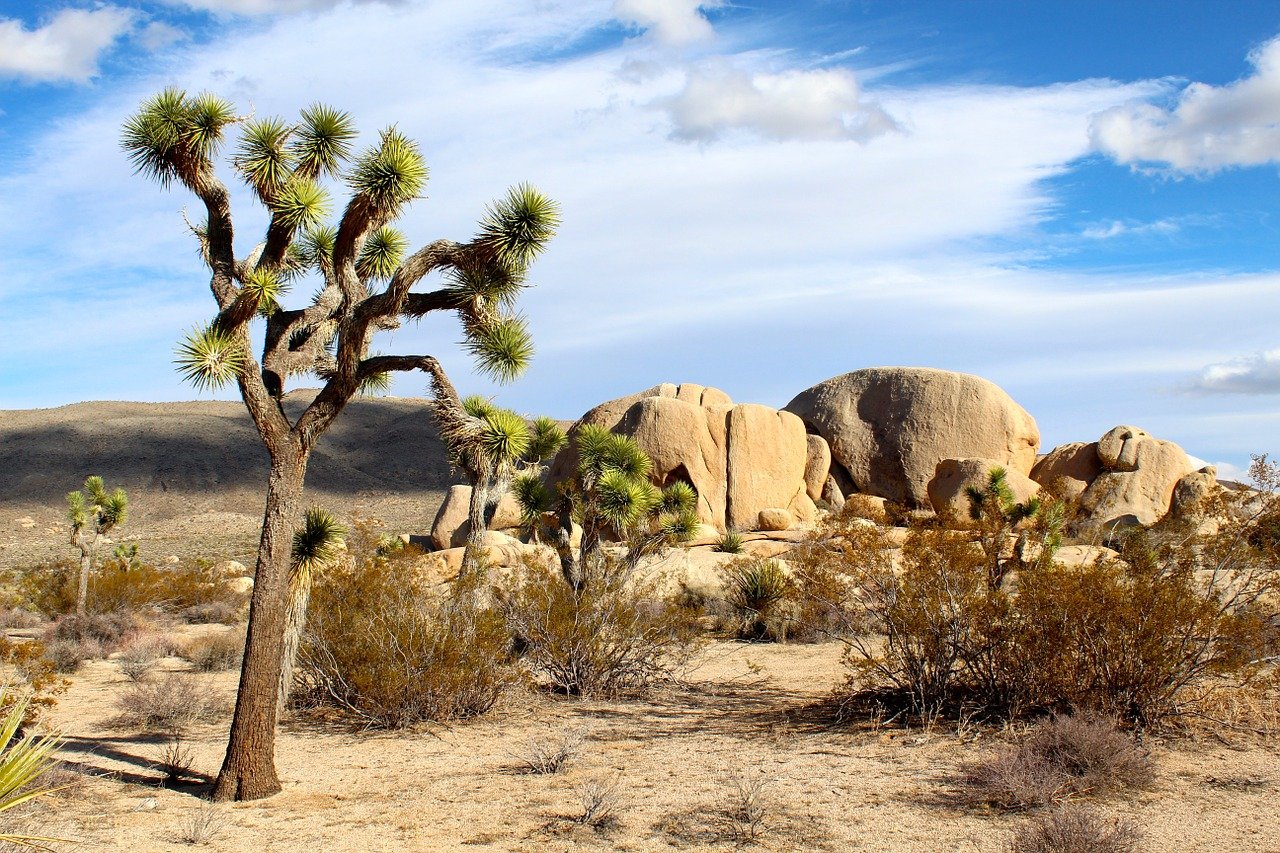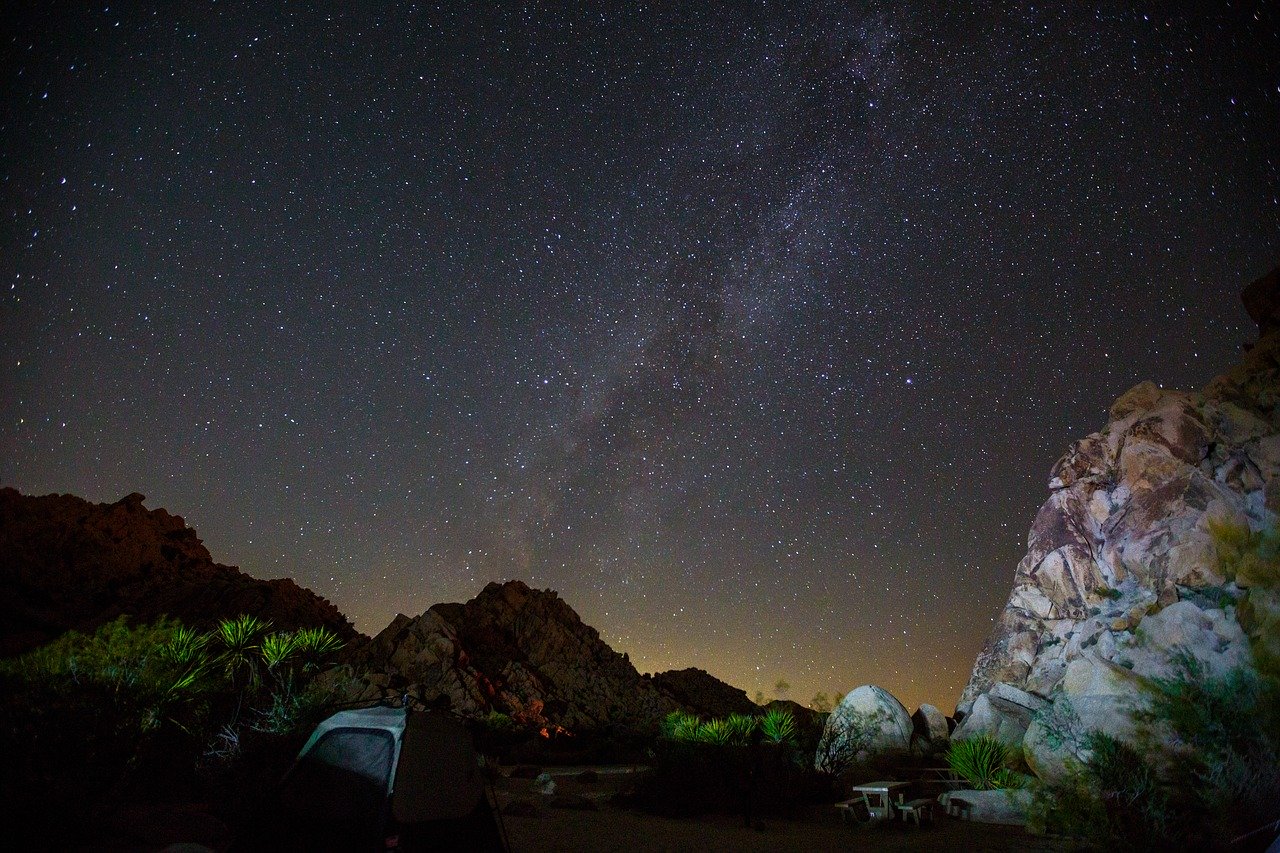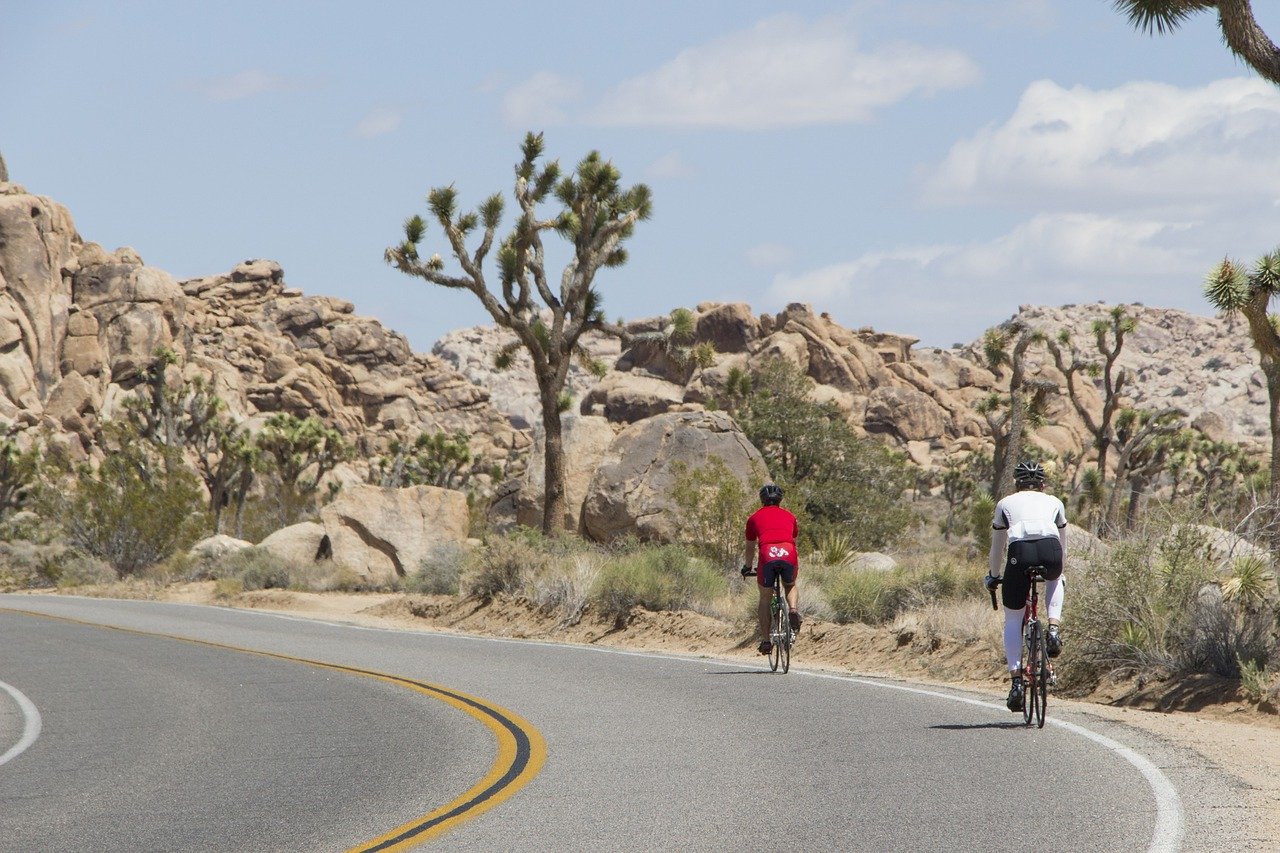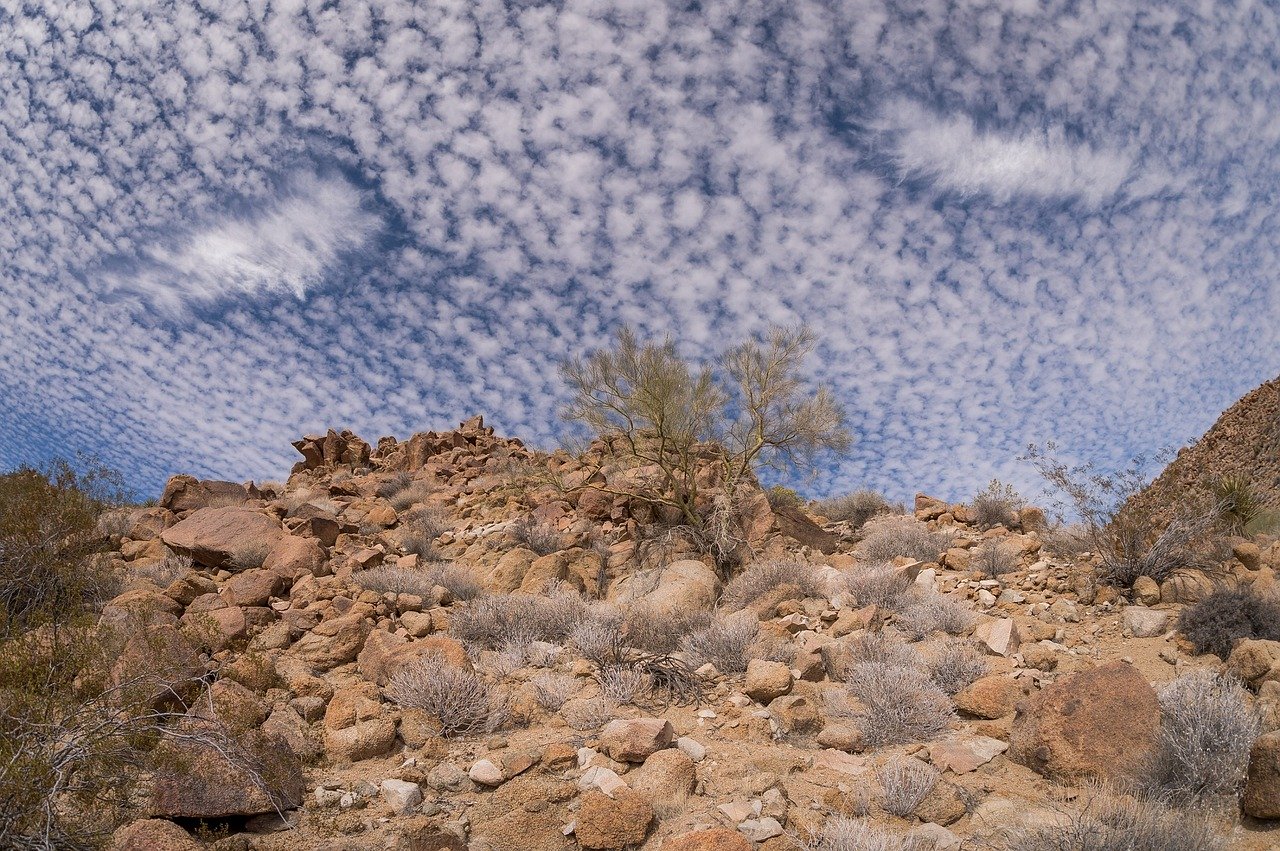Named after the unusually and short shaped trees scattered throughout this park, Joshua National Park provides a quirky history and awe-inspiring beauty. These vast desert landscapes have attracted rustlers, cattle ranchers, Mormon pioneers, nature lovers, and adventure seekers over many years.
This park is 1 to 3 hours away from the residents of Southern California, which makes it one of the popular weekend getaways. With over 100-miles of exciting hiking trails, several rock formations to scramble over and climb, and fantastic stargazing opportunities, this destination is worthwhile for both international and out-of-state visitors.
Fast Facts About Joshua Tree National Park
It’s A Fantastic Place For Stargazing
Designated as an International Dark Sky Park by the International Dark-Sky Association, this national park provides excellent opportunities to catch glimpses of the Milky Way and the stars.
Many people reside in urban neighborhoods surrounded by constant artificial light, making it difficult to enjoy the beauty of the stars. By limiting artificial light when it gets dark, Joshua Tree offers ample opportunity to view the sky along with countless stars on clear nights.
Magnificent Wildflowers
You may associate the desert with very little vegetation. Yet there are more than 700 plant species to be discovered in this park. From February to May, vibrant wildflowers start blooming in February, while the higher-elevations blooms are still around into June.
The location and extent of these blooms do change every year according to the weather. It is advisable to do a bit of research before you plan a trip to see these flowers.
This Area Has An Extensive History Of Homesteading
The Keys (Bill and Frances) spent over six decades in this area cattle ranching, mining, and raising children. Their former schoolhouse, workshop, and home still stand. This site is also listed on the National Register of Historic Places.
Where Is Joshua Tree National Park?
Joshua Tree National Park is one of the American national parks located in southeastern California, to the east of San Bernardino and Los Angeles, close to Palm Springs.
Situated between the border of Riverside County and San Bernardino County, this park features portions of 2 deserts, with each that has an ecosystem that has characteristics mainly determined by the elevation. This includes the lower Colorado Desert and the higher Mojave Desert. The Little San Bernardino Mountains cross over the south-western edge of this park.
Joshua Tree National Park Hours
This national park stays open throughout the year.
- The Joshua Tree and Oasis Vistors Centers are open every day from 8.00 am to 5.00 pm.
- The Black Rock Nature Center is open from 8:00 am to 4:00 pm from October through to May, excepting on Fridays, where the center only opens from noon to 8:00 pm.
- The Cottonwood Visitors Center opens every day from 9:00 am to 3:00 pm.
Joshua Tree National Park Entrance Fee
Entrance into the park is $30 for single-vehicle permits, lasting up to 7 days. Entrance fees for motorcycles are $25, and the fee for individuals on a bicycle or on foot is $15.
Joshua Tree National Park Weather
Spring
The best time to visit Joshua Tree National Park is in the early part of spring. The temperatures are cool at night and mild during the day. Spring is also a popular time of the year to see the beautiful wildflowers.
If you love rock climbing and hiking, March, April, and the beginning of May are rated as the ideal months. One of the drawbacks around these times is the crowds. If you decide to visit during the week it is less crowded, but over the weekends it can get extremely busy.
The busiest times include the Easter weekend and school vacations. The park also becomes extremely busy for the Joshua Tree Musical Festival, which is an event held outside the gates of the park.
Finding campsites inside the park is often challenging during spring, but there are also great campgrounds to consider close to the park on the outside.
Summer
Summer is not a popular season for Joshua Tree since the daytime temperatures often soar.
This park is located in the desert so you can expect the temps to top 38˚C (100˚F) in June, July, and August. This can make outdoor adventures such as rock climbing and hiking potentially dangerous and uncomfortable. Heatstroke is one of the concerns when the temperatures start to spike.
If you do decide to camp in Joshua Tree National Park in summer, it is advisable to limit any physical activities to the late afternoon or early morning. It is also important to ensure you stay well hydrated.
You may be wondering why people would want to visit this park in summer. Well, to begin with, there are a lot fewer people and the opportunity to secure one of the prime campsites even on a weekend.
Summer is also one of the best times of the years to watch the stars and the temps are fantastic at night. August is also a famous month for the Perseid Meteor Shower.
Fall
The late part of the fall is also one of the best times to visit the park. The temperatures may still be hot and dry in September, but by October everything starts to cool off. If you love photography, you will really enjoy how the golden light illuminates some of the rock formations.
November or Octobers are 2 of the most popular months to camp at Joshua Tree. The temperatures are mild, and not so crowded like the park is in spring. During this time of the year, there are also fantastic festivals held just outside Joshua Tree, include the Bhakti Fest, and the Joshua Tree Music Festival.
Winter
The cold temperatures keep most of the visitors away from the park over the winter months. However, over the last few years, December, January, and even February have also started to increase in popularity. This is mainly driven by the rock climbers that flock to Joshua Tree when the famous summer destinations such as Yosemite are all covered by a thick layer of snow.
Snowfall is extremely rare in these parts, but it can still happen. If you do visit the park during one of the snowstorms, the scenery is breathtaking.
Things To Do In Joshua Tree National Park
The abundance of awe-inspiring ecological and geological sights in Joshua Tree National Park offers countless opportunities to explore this beautiful landscape.
Stargazing
Joshua Tree National Park is also classified as a Silver Tier International Dark Sky Park, meaning that after dark things can get pretty extraordinary. Even though the location is mainly remote, the western areas of this park still experience a degree of light-pollution from Palm Springs nearby.
We suggest that you stay in the central parts, especially along Pinto Basin Road. This is one of the perfect spots to see full moons, the Big Dipper, shooting stars, and the Milky Way.
Wildlife Spotting
Joshua Tree is well known for its diverse flora and fauna, along with lots of wildlife to spot. Birding is extremely popular, including native species such as raptors, roadrunners, along with several migratory flocks. You will need a lot of patience and a good pair of binoculars.
This area is also well-known for large desert predators such as snakes, coyotes, bobcats, and more. Visitors should be vigilant when it comes to their surroundings and practice caution while out in the wild.
Climbing And Hiking
There are many rock-climbing routes throughout this park, which makes it one of the most popular destinations for both boulderers and climbers of any skill level. Many of them are close to the Hidden Valley area, and if you are unsure of where you should be starting, you can ask one of the professional guides to assist you in finding one the less-crowded routes.
Scenic Routes
There are many scenic routes to enjoy, with Skull Rock rated as one of the favorites for Instagrammers due to the amazing Wonderland of Rocks.
There are also many trails to choose from for mountain bikes and even to ride horses. The roads that wind through this park are also ideal for motorcyclists. It is important to keep a lookout for tortoises that cross the road.
Joshua Tree National Park Trails
Joshua Tree National Park offers several fantastic areas to explore. Here are some of the hikes to consider when visiting this park:
Ryan Ranch Trail:
0.8 mile
This family-friendly hike leads to the remains of a 100-year-old homestead. If the light is right, you will notice the shimmering adobe bricks that contain gold dust collected from a mine nearby.
Arch Rock Nature Trail:
0.3 mile
This hike starts from the White Tank Campground through an arch and maze of rock formations along with many crannies to discover and scramble around.
Hidden Valley Nature Trail:
1 mile
This brief hike offers an interesting tour of Joshua trees and picture-perfect rock formations, situated close to a popular campground and picnic area.
Barker Dam Trail:
1.1 miles
This nature loop comes with signs providing an easy self-guided tour with excellent chances to spot an abundance of wildlife. Jackrabbits, bighorn sheep, and several birds use this area frequently to drink from the reservoir.
Split Rock Loop
2 miles
This hike is near to Skull Rock, yet this spot doesn’t attract as much attention, perhaps since the name is less dramatic. The intricate rock formations are just as interesting, and you can expect to find solitude in this area.
Skull Rock Nature Trail:
1.7 miles
The skull-shaped rock is just one of the highlights along this loop. You can also enjoy the wildflowers, unique plant life, expansive views, along with hidden spots to discover among the interesting rock formations.
Mastodon Peak Loop/Cottonwood Springs Nature Trail
2.5 miles
The desert really looks very different on this hike when compared to the others. There are no Joshua trees, but rather shady palm trees and cottonwood groves in this tranquil oasis. You can also hike up to the Mastodon Peak for views over the Coachella Valley.
Fortynine Palms Oasis
3 miles
This is an oasis that is welcomed in the hot, searing desert, and it is not a mirage. After a long hike in the hot sun, you can enjoy the shade of the towering palms and the natural water pools. This area is also full of wildlife and flora.
Ryan Mountain Hike
3 miles
Among the widest of panoramas in this park can be found on top of the 5,457-foot Ryan Mountain. The trail to the top is easy-to-follow and well-maintained, but it is steep and the stairway is also exposed to the wind and the sun.
Wall Street Mill Hike
2.8 miles
Close to the Barker Dam Trail, this hike is slightly longer taking you to another popular historic site. The area was once a mill that was used for refining gold ore. The area features the remains of a ranch and the mill, giving you an idea of what it was once like in these rugged desert areas for people in pursuit of wealth over 100 years ago.
The Maze Loop
6.5 miles
The clear trail markers make these adventures a lot less complex than it actually sounds, yet it is important to keep track of your surroundings to ensure you stay on the right path. The “Maze” winds through miles of rock formations, cactus gardens, Joshua trees, along with an expanse of desert wildflowers.
Camping In Joshua Tree National Park
Camping is a spectacular experience in this national park, with beautiful campgrounds around the impressive rock formations, along with the ideal sites to pitch your tent or set up an RV.
It is difficult to decide on whether one campground or site is better when compared to others, and in some cases deciding where you would like to camp has more to do with what is available on your arrival.
Hidden Valley Campground
This campground is available for both RVs and tents. It is also among the most popular camping site in this park. It is conveniently close to several hiking trails, and some of the favorite climbing sites that this park has to offer. this campground is busiest in the high-season. Since the park works on a first-come, first-served basis, it is recommended to arrive early if want to camp here.
The campsites are spread spectacularly among the massive rock formations that are all dotted with large and mature Joshua trees. It is also a quiet campsite since generators are prohibited. Hidden Valley Campground is rated the best campsite in this park and the ideal spot to camp when you are able to secure a site.
This campground is also the closest to the West Entrance Station, which is on the western end of this park. It is also well-known as a highly scenic area of this national park.
Belle Campground
Close to White Tank Campground, towards the Twentynine Palms, Belle Campground is very similar to White Tank. There are large boulders and a few Joshua trees around the campsites.
There are 18 first-come, first-serve sites to choose from, with most that can only accommodate one large tent. Generators are prohibited at this campground.
Belle and White Tank are both tranquil and serene sites, while still conveniently located to Park Boulevard and the other attractions such as Skull Rock.
White Tank Campground
On the eastern side of this park is White Tank Campground, which is situated on a roadway between Cottonwood and the North Entrance Station.
This landscape is strewn with boulders providing a fantastic location for campsites, offering privacy, and many places to explore the rock formations. It also has a few Joshua trees that add to the atmosphere.
This campground only has 15 well-placed campsites along with many surrounding rocks that offer privacy. This is one of the best options for the campers that prefer privacy and quieter camping experiences. Generators are also prohibited in this area, while RVs have to be under 25 feet.
Ryan Campground
Ryan Campground is often used as an “overflow” campground for campers that were unable to secure a spot at Hidden Valley. Yet this doesn’t necessarily mean that it’s just a sandy patch of ground.
This is also a lovely camping spot, that offers spacious sites, yet less privacy, when compared to many of the other campgrounds, spread throughout this park. Generators are also prohibited at Ryan Campground.
This campground is also well-positioned if you prefer to camp at the western end of this park.
Jumbo Rocks Campground
This is the biggest campground in this park, offering 124 sites to choose from. This is also a campground that offers you a better chance of securing a campsite inside the park’s gates.
Located centrally in this national park, the sites are set around massive rock formations with sheer-cliff faces along with a few mature Joshua trees. This campground offers a mixture of small or spacious campsites.
A few of the sites are available to RVs of up to 32-feet, while others can only accommodate small tents. Yet even the small campsites that are close to the road and can only take a tent are still regarded as one of the best campsites when compared to other parks due to their locations under towering rock formations and the stunning sunsets that reflect off the rocks.
This is a stunning campground, offering many sites to choose from to pitch your tent or park your RV.
Indian Cove Campground
This is one of the decent camping spots, located outside the gates to the entrance of this park, close to Twentynine Palms. The entrance to the campground can be accessed off Highway 62.
When you drive into this campground, it does look similar to a moonscape with relatively barren areas along with giant monoliths and small boulders piled high.
This campground is located at a much lower elevation, offering only a bit of vegetation and small trees. One of the benefits to Indian Cove is that you can reserve a campsite in high-season, which runs from October through to May.
This campground offers 101 campsites for both RVs and tents, accomodating RVs up to 35 feet. This campground also offers dedicated group campsites.
Generators are permitted, but you can only use them for 2 hours at a time at specified times.
Black Rock Campground
Black Rock Campground, is off Highway 62, to the west of Joshua Tree town. This is a very scenic campground filled with Joshua trees. It is also known as one of the favorite bird-watching areas.
The drawback of this campground has to do with how far away it is to the main sections and attractions of this park. It is around a 45-minute drive from the main areas of the park. The campsites are reservable which is important to keep in mind during high season.
This is also the campground that is closest to the main population centers of the west. Yucca Valley is only 5 miles away.
The campsites come with fire rings and picnic tables, and the campground also features flushable toilets. Generators are permitted at certain times of the day.
There are also separate areas dedicated to horse owners for both staging and camping.
Cottonwood Campground
This campground is far from the popular attractions and is also the least-scenic in this park. The campsites are spread widely apart among the scrub trees. The campground is also at a much lower elevation of only 3,000 feet, making it much warmer when compared to many other areas in Joshua Tree National Park.
This campground is situated on the south-eastern side of this park and can be a great option if you prefer to camp close to Interstate 10.
These sites come with fire rings and picnic tables. There is also portable water from a single tap from each of the campground loops. There are also toilets available, but no showers.
Generators are permitted for 2-hours every day at a specified time.
Camping On BLM Land Outside The Park
There are 2 free camping areas available when the park is full, and when you prefer not to camp at one of the commercial campgrounds close to the entrance of the park. One of these sites is located to the north from the entrance of the park. Drive 2.5-miles along Sunfair Road, and turn right into Sunflower Road. When you reach the junctions of Cascade and Sunflower Road, there is a designated camping area. Campfires are not permitted in this area.
The second camping spot is to the south and is much bigger. This area is also a lot more scenic. As you leave the park from Cottonwood Springs Road, there are a few side roads that either head west or east. Either road will lead you to this scenic spot.
To the south of Interstate 10 are also dispersed camping opportunities. You can light a campfire in these areas, but you must have a permit that you can access on the BLM website.
Hotels Near Joshua Tree National Park
If you cannot secure one of the campsites, in some cases you may need to think about finding a hotel. If you are traveling with camping equipment, use the well-equipped day-use areas of the park to cook meals, spending daylight areas enjoying the natural surroundings, and stay in one of the hotels at night.
The best hotels, mainly budget and mid-range are situated in Twentynine Palms, along Highway 62, close to the park. Here is a list of some of the great-value hotels in Twentynine Palms.
Mid-Range Hotels
The Fairfield Inn and Suites are among the favorite hotels within this category. This all-suite hotel offers a heated pool and complimentary breakfast. It is also situated close to the park. Other popular options include SureStay Plus by Best Western and the Holiday Inn Express Hotel and Suites, both offer free breakfast, large pools, and parking facilities.
Budget Hotels
Motel 6 Twentynine Palms, is a reasonably-priced pet-friendly hotel that has recently undergone renovations. The rooms are decent along with an outdoor hot tub and heated pool. The 9 Palms Inn is another great-value motel. This motel-style, single-story building features colorful rooms. The Rodeway Inn and Suites is another no-frills well-situated hotel that offers complimentary breakfast along with an outdoor hot tub and pool.
- 15 Best Free Online Virtual Summer Camps for Kids (2022) - July 6, 2021
- Expert Roundup: Advice to Mitigate the Effects of Coronavirus - March 22, 2021
- Best Gifts for Travelers - January 15, 2021
